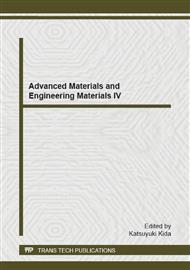[1]
Y. Han, H. Guo, X. Zhang, F. Yin, K. Chu, and Y. Fan, Thermal performance analysis of LED with multichips, Journal of Wuhan University of Technology-Mater. Sci. Ed., vol. 26, pp.1089-1092, (2011).
DOI: 10.1007/s11595-011-0368-0
Google Scholar
[2]
P. Anithambigai, K. Dinash, D. Mutharasu, S. Shanmugan, and C. K. Lim, Thermal analysis of power LED employing dual interface method and water flow as a cooling system, Thermochimica Acta, vol. 523, pp.237-244, (2011).
DOI: 10.1016/j.tca.2011.06.001
Google Scholar
[3]
W. Jun, Z. Meilin, L. Shuzhi, Y. Weiqiao, and Z. Jianhua, Study on the application of thermal interface materials for integration of HP-LEDs, in CPMT Symposium Japan, 2010 IEEE, 2010, pp.1-5.
DOI: 10.1109/cpmtsympj.2010.5680285
Google Scholar
[4]
N. Teeba, L. Kean Yew, L. C. Keng, P. Anithambigai, K. Dinash, and D. Mutharasu, Study on the variation in thermal resistance and junction temperature of GaN based LEDs using thermal transient measurement, in Quality Electronic Design (ASQED), 2011 3rd Asia Symposium on, 2011, pp.310-314.
DOI: 10.1109/asqed.2011.6111766
Google Scholar
[5]
C. P. Wang, T. T. Chen, H. K. Fu, T. L. Chang, and P. T. Chou, Transient Analysis of Partial Thermal Characteristics of Multistructure Power LEDs, Electron Devices, IEEE Transactions on, vol. 60, pp.1668-1672, (2013).
DOI: 10.1109/ted.2013.2252903
Google Scholar
[6]
R. Vairavan, Z. Sauli, V. Retnasamy, N. Khalid, K. Anwar, and N. Abdullah, Natural Heat Convection Analysis on Cylindrical Al Slug of LED, Applied Mechanics and Materials, vol. 487, pp.536-539, (2014).
DOI: 10.4028/www.scientific.net/amm.487.536
Google Scholar
[7]
R. Vairavan, Z. Sauli, V. Retnasamy, R. C. Ismail, N. I. M. Nor, N. S. Nadzri, and H. Kamarudin, High Power LED Thermal and Stress Simulation on Copper Slug, in Computer Modelling and Simulation (UKSim), 2013 UKSim 15th International Conference on, 2013, pp.294-298.
DOI: 10.1109/uksim.2013.150
Google Scholar
[8]
D. Butterworth and D. Council, Introduction to heat transfer vol. 18: Oxford University Press for the Design Council, the British Standards Institution and the Council of Engineering Institutions, (1977).
Google Scholar
[9]
H. H. Cheng, D. -S. Huang, and M. -T. Lin, Heat dissipation design and analysis of high power LED array using the finite element method, Microelectronics Reliability, vol. 52, pp.905-911, (2012).
DOI: 10.1016/j.microrel.2011.05.009
Google Scholar


